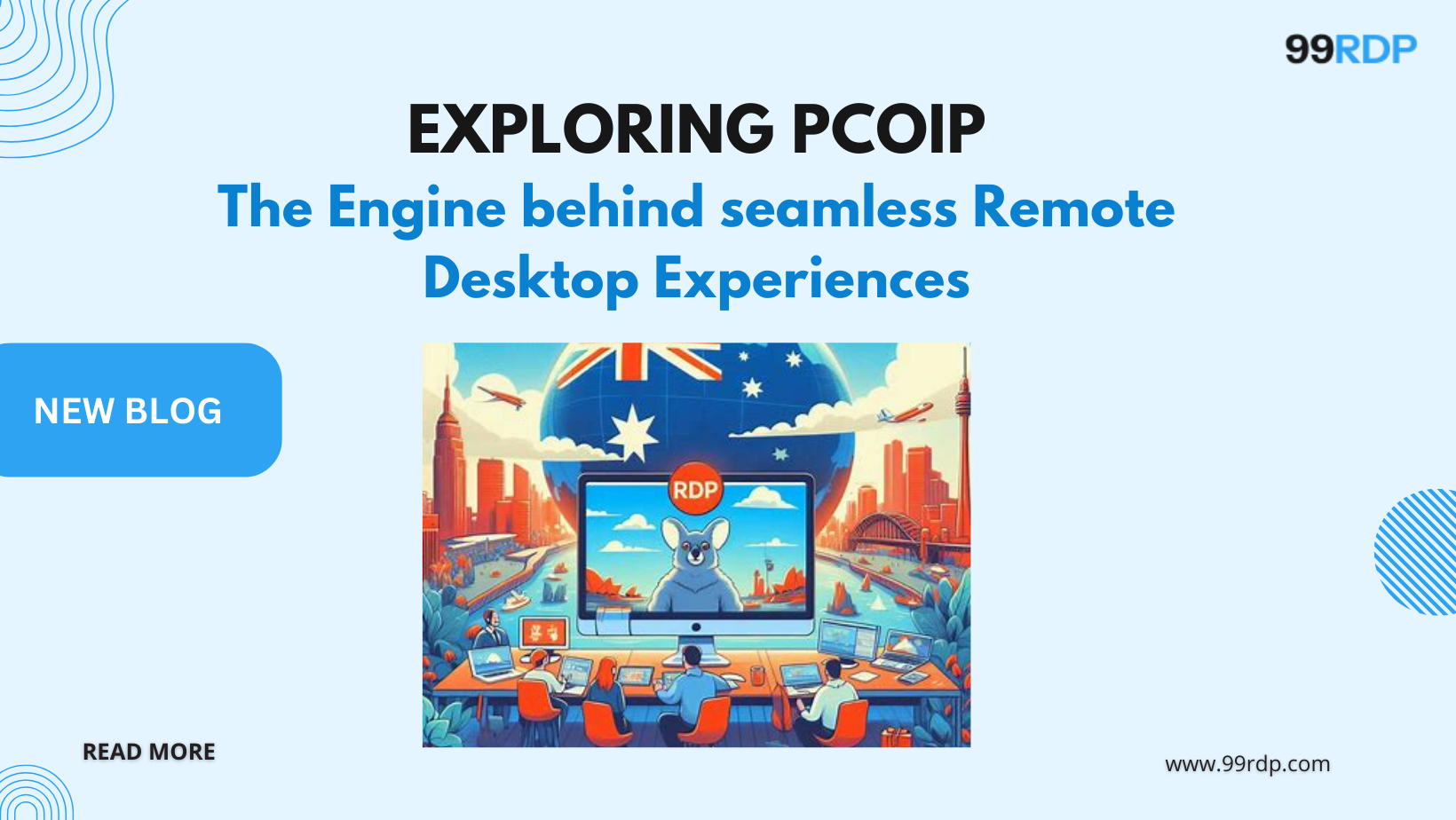Exploring PCoIP
Exploring PCoIP: The Engine Behind Seamless Remote Desktop Experiences.
In 2020, as the COVID-19 pandemic swept across the globe, countless businesses pivoted to remote work. What began as a necessity has since evolved into a mainstay of the modern workforce, prompting organizations to adopt sophisticated technologies like PC-over-IP (PCoIP) to support their operations.
Here’s a closer look at PCoIP:
- First introduced by Teradici in 2007, PCoIP has undergone continuous enhancements, establishing itself as a premier solution for desktop virtualization and display protocols.
- What distinguishes PCoIP from other protocols is its use of the User Datagram Protocol (UDP) rather than the more common Transmission Control Protocol (TCP). This allows for more efficient process-to-process communication, particularly in environments with higher latency.
- So, what does this mean in practice? PCoIP offers a streamlined and highly responsive method for delivering virtual desktops and applications, optimizing the user experience.
- Why is PCoIP considered a superior protocol? Its reliance on UDP ensures improved performance, especially over less-than-ideal network conditions, while maintaining high levels of security and versatility.
- How does PCoIP compare to other protocols? Its ability to balance efficiency, security, and adaptability makes it a favored choice for many organizations.
In this post, we’ll explore the intricacies of PCoIP, delve into what makes it a standout protocol, and evaluate how it stacks up against competing solutions. Let’s begin.

Exploring PCoIP: What It Is and Where It’s Applied
PCoIP is a powerful display protocol that compresses an entire desktop, delivering it seamlessly through a zero-client device over a standard IP network. This method earned it the name “PC over IP.”
Here’s how PCoIP works and why it’s widely used:
- Enables Desktop Virtualization: PCoIP allows users to view and interact with another desktop in real time, offering an experience as smooth as watching a movie.
- Uses UDP for Faster Communication: Unlike traditional protocols, PCoIP leverages the User Datagram Protocol (UDP) instead of TCP. This enables a low-latency, loss-tolerant connection, where the protocol efficiently sends a pixel map (including positions and colors) from the source desktop to the destination screen.
- Ensures Data Security: Security remains a priority with PCoIP. It encrypts all data before transmission, ensuring that it’s safely sent to the target device, where it is decrypted and displayed. This encryption is one of the reasons platforms like VMware Horizon Cloud and Amazon WorkSpaces trust PCoIP to stream virtual desktops.
- Supports Multiple Devices: Flexibility is key with PCoIP. Users can access cloud-hosted desktops not just from their desktops but also from mobile phones and tablets via the desktop-as-a-service (DaaS) model.
- Thin Client Compatibility: PCoIP also works with thin clients—desktops that rely on a central server for resources instead of a local hard drive.
- VPN Alternative: Beyond virtual desktops, PCoIP can act as a backup Virtual Private Network (VPN) solution, especially when a company’s corporate firewall is down or deactivated.
- Optimizes Network Performance: PCoIP can optimize bandwidth usage on both WANs and LANs, improving speed and efficiency across networks.
- Financial Sector Applications: PCoIP’s low-latency performance makes it ideal for traders and financial analysts, offering real-time access to trading platforms and financial data.
While other protocols offer similar functions, PCoIP stands out for its security, speed, and flexibility, making it a preferred choice for a wide range of applications.
Key Features and Benefits of Using PCoIP
Before we get into the technical features and benefits of PCoIP, here are some of the main features of PCoIP:
- Supports 32-bit color for virtual displays.
- Supports ClearType fonts.
- Dynamic audio quality adjustment for LAN and WAN through audio redirection.
- Supports real-time Audio-Video for webcams and microphones on some client types.
- Supports copying and pasting text and images between the client OS and a remote desktop or published application.
However, copying and pasting images may not be available for some clients. - Supports up to four monitors with a resolution of 2560 x 1600 per display or up to three monitors with a 4K resolution (3840 x 2160). Additionally, features like pivot display and autofit are also supported.
- USB and MMR redirection are also supported.
Exploring PCoIP; Security Features
- PCoIP transmits only encrypted pixel data, not actual application or file data.
- This ensures that sensitive information stays securely in the data center or cloud.
- As a result, the risk of data breaches at the client endpoint is greatly reduced.
- PCoIP uses AES-256 encryption, one of the strongest encryption algorithms available.
- AES-256 is nearly impossible to break and would take 10 to 18 years to breach with extraordinary resources.
Benefits of UDP Over TCP
- PCoIP has become one of the leading protocols for desktop virtualization and display for good reasons.
- Its use of UDP provides key advantages over TCP-based protocols.
- Unlike TCP, UDP sends data packets without waiting for acknowledgment, reducing latency.
- This allows faster speeds in use cases like remote desktop and media streaming, with minimal data loss in stable networks.
- UDP also ensures consistent data transmission, even during network congestion.
- PCoIP adapts to network changes by adjusting image quality instead of slowing down data transfer.
- This makes PCoIP ideal for high-bandwidth tasks like video editing and 3D rendering, where smooth performance is essential.
Efficient Image Decomposition Through Multiple Codecs
- Normally, your workstation handles tasks like displaying text, graphics, and video on different parts of the screen.
- Each area of the display has different requirements based on the task running in that specific section.
- Using the same compression for the entire display slows down performance and becomes inefficient.
- PCoIP solves this with a multi-codec protocol that supports multiple image element types.
- It analyzes and decomposes image elements for text, graphics, icons, and video.
- This allows PCoIP to transmit these elements more quickly and efficiently, saving bandwidth.
- For tasks involving critical information, like medical records, PCoIP codecs ensure high-quality, lossless transmission of rapidly changing image elements.
Optimized Performance with Host-Based Rendering
PCoIP removes the need for the client to have high-grade equipment and specific hardware by having the images generated by applications processed on the host’s side. This approach allows images that require robust software and hardware to be seamlessly delivered to the client in pixel data, mimicking how a TV broadcast streams video to your screen.
Issues and Drawbacks with PCoIP
PC over IP isn’t perfect, and while it may have many advantages over other protocols, PCoIP may not be the best protocol for you, depending on your use case.
Network Dependency and Packet Loss
As I mentioned earlier, PCoIP prioritizes speed over avoiding packet loss, and while PCoIP’s adaptability allows it to function well under poor network environments, the packet loss may become too much. This can lead to many serious issues like reduced display frame rates, choppy video, and delayed input responses.
End of Support in VMware Horizon
A leading virtual desktop infrastructure (VDI), VMware Horizon is a platform that allows organizations to deliver virtual desktops and applications to end users. VMware Horizon has been supporting PC over IP since 2009; however, in 2013, VMware developed its own protocol called BLAST and recently announced that it will only support PCoIP until the end of 2025.
That said, VMware Horizon releases are supported for three years from the ship date, so the client and agent shipped in 2025 will get PCoIP support until 2028. After that, PCoIP will be fully removed from all Horizon releases.
Compatibility and Transition Issues
- PCoIP is tightly integrated into the VMware Horizon ecosystem and performs well in that environment.
- However, PCoIP has limited compatibility with non-VMware platforms.
- This makes it challenging to switch from PCoIP to other protocols like RDP.
EXPLORE MORE






